Predefined-Time Fault-Tolerant Trajectory Tracking Control for Autonomous Underwater Vehicles Considering Actuator Saturation
Abstract
:1. Introduction
- A predefined-time sliding mode controller is developed based on a predefined-time disturbance observer. This is achieved by incorporating a novel predefined-time auxiliary system to prevent the control input from surpassing the actuator’s physical limitations;
- A non-singular backstepping approach is designed to avoid potential singularities in the predefined-time sliding mode controller, ensuring that the trajectory tracking error remains uniformly ultimately bounded (UUB) within the predefined time.
2. Preliminaries
2.1. AUV Dynamic Model
2.2. Definitions and Lemmas
3. Main Results
3.1. Predefined-Time Sliding Mode Controller
3.2. Design of Predefined-Time Sliding Mode Controller
3.3. Design of Nonsingular, Practical Predefined-Time Controller
4. Simulation Cases
4.1. Case 1: Disturbance-Observer-Based Predefined-Time Control
4.2. Case 2: Disturbance-Observer-Based Practical Predefined-Time Control
5. Conclusions
Author Contributions
Funding
Data Availability Statement
Conflicts of Interest
References
- Editorial, G. Emerging Trends in LPV-Based Control of Intelligent Automotive Systems. IET Control. Theory Appl. 2020, 14, 2715–2716. [Google Scholar] [CrossRef]
- Ali, N.; Tawiah, I.; Zhang, W. Finite-time extended state observer based nonsingular fast terminal sliding mode control of autonomous underwater vehicles. Ocean. Eng. 2020, 218, 108179. [Google Scholar] [CrossRef]
- Liu, X.; Zhang, M.; Chen, J.; Yin, B. Trajectory tracking with quaternion-based attitude representation for autonomous underwater vehicle based on terminal sliding mode control. Appl. Ocean Res. 2020, 104, 102342. [Google Scholar] [CrossRef]
- Sun, H.; Zong, G.; Cui, J.; Shi, K. Fixed-time sliding mode output feedback tracking control for autonomous underwater vehicle with prescribed performance constraint. Ocean Eng. 2022, 247, 110673. [Google Scholar] [CrossRef]
- Huang, B.; Zhou, B.; Zhang, S.; Zhu, C. Adaptive prescribed performance tracking control for underactuated autonomous underwater vehicles with input quantization. Ocean Eng. 2021, 221, 108549. [Google Scholar] [CrossRef]
- Zhou, B.; Su, Y.; Huang, B.; Wang, W.; Zhang, E. Trajectory tracking control for autonomous underwater vehicles under quantized state feedback and ocean disturbances. Ocean Eng. 2022, 256, 111500. [Google Scholar] [CrossRef]
- Gan, W.; Zhu, D.; Ji, D. QPSO-model predictive control-based approach to dynamic trajectory tracking control for unmanned underwater vehicles. Ocean Eng. 2018, 158, 208–220. [Google Scholar] [CrossRef]
- Sedaghati, S.; Abdollahi, F.; Khorasani, K. Model predictive and non-cooperative dynamic game fault recovery control strategies for a network of unmanned underwater vehicles. Int. J. Control. 2019, 92, 489–517. [Google Scholar] [CrossRef]
- Han, L.; Tang, G.; Cheng, M.; Huang, H.; Xie, D. Adaptive Nonsingular Fast Terminal Sliding Mode Tracking Control for an Underwater Vehicle-Manipulator System with Extended State Observer. J. Mar. Sci. Eng. 2021, 9, 501. [Google Scholar] [CrossRef]
- Li, J.; Du, J.; Zhu, G.; Lewis, F.L. Simple adaptive trajectory tracking control of underactuated autonomous underwater vehicles under LOS range and angle constraints. IET Control. Theory Appl. 2020, 14, 283–290. [Google Scholar] [CrossRef]
- Xu, R.; Tang, G.; Huang, D.; Xie, D.; Han, L. Adaptive fault-tolerant attitude control for a CMG-based underwater vehicle. J. Mar. Sci. Technol. 2020, 25, 800–807. [Google Scholar] [CrossRef]
- Liu, X.; Zhang, M.; Rogers, E. Trajectory Tracking Control for Autonomous Underwater Vehicles Based on Fuzzy Re-Planning of a Local Desired Trajectory. IEEE Trans. Veh. Technol. 2019, 68, 11657–11667. [Google Scholar] [CrossRef]
- Wang, X.; Tan, C.P. Dynamic Output Feedback Fault Tolerant Control for Unmanned Underwater Vehicles. IEEE Trans. Veh. Technol. 2020, 69, 3693–3702. [Google Scholar] [CrossRef]
- Xiang, X.; Yu, C.; Zhang, Q. On intelligent risk analysis and critical decision of underwater robotic vehicle. Ocean Eng. 2017, 140, 453–465. [Google Scholar] [CrossRef]
- Liu, X.; Zhang, M.; Wang, S. Adaptive region tracking control with prescribed transient performance for autonomous underwater vehicle with thruster fault. Ocean Eng. 2020, 196, 106804. [Google Scholar] [CrossRef]
- Qin, H.; Wu, Z.; Sun, Y.; Chen, H. Disturbance-Observer-Based Prescribed Performance Fault-Tolerant Trajectory Tracking Control for Ocean Bottom Flying Node. IEEE Access 2019, 7, 49004–49013. [Google Scholar] [CrossRef]
- Hu, Q.; Shao, X.; Chen, W.-H. Robust Fault-Tolerant Tracking Control for Spacecraft Proximity Operations Using Time-Varying Sliding Mode. IEEE Trans. Aerosp. Electron. Syst. 2018, 54, 2–17. [Google Scholar] [CrossRef] [Green Version]
- Fang, X.; Fan, H.; Wang, W.; Liu, L.; Wang, B.; Cheng, Z. Adaptive Finite-Time Fault-Tolerant Control of Uncertain Systems With Input Saturation. IEEE Trans. Syst. Man Cybern. Syst. 2022, 165–177. [Google Scholar] [CrossRef]
- Hao, L.-Y.; Yu, Y.; Li, H. Fault tolerant control of UMV based on sliding mode output feedback. Appl. Math. Comput. 2019, 359, 433–455. [Google Scholar] [CrossRef]
- Qin, H.; Chen, H.; Sun, Y. Distributed finite-time fault-tolerant containment control for multiple ocean bottom flying nodes. J. Frankl. Inst. Eng. Appl. Math. 2020, 357, 11242–11264. [Google Scholar] [CrossRef]
- Liu, F.; Tang, H.; Qin, Y.; Duan, C.; Luo, J.; Pu, H. Review on fault diagnosis of unmanned underwater vehicles. Ocean Eng. 2022, 243, 110290. [Google Scholar] [CrossRef]
- Merrill, W.C.; DeLaat, J.C.; Bruton, W.M. Advanced detection, isolation, and accommodation of sensor failures-Real-time evaluation. J. Guid. Control. Dyn. 1988, 11, 517–526. [Google Scholar] [CrossRef] [Green Version]
- Lunze, J.; Richter, J.H. Reconfigurable Fault-tolerant Control: A Tutorial Introduction. Eur. J. Control. 2008, 14, 359–386. [Google Scholar] [CrossRef]
- Behzad, H.; Casavola, A.; Tedesco, F.; Ali Sadrnia, M.; Gagliardi, G. A Fault-Tolerant Sensor Reconciliation Scheme based on Self-Tuning LPV Observers. In Proceedings of the 15th International Conference on Informatics in Control, Automation and Robotics, Porto, Portugal, 29–31 July 2018; pp. 111–118. [Google Scholar]
- Kadiyam, J.; Parashar, A.; Mohan, S.; Deshmukh, D. Actuator fault-tolerant control study of an underwater robot with four rotatable thrusters. Ocean Eng. 2020, 197, 106929. [Google Scholar] [CrossRef]
- Liu, X.; Zhang, M.; Yao, F. Adaptive fault tolerant control and thruster fault reconstruction for autonomous underwater vehicle. Ocean Eng. 2018, 155, 10–23. [Google Scholar] [CrossRef]
- Wu, C.; Yan, J.; Shen, J.; Wu, X.; Xiao, B. Predefined-time attitude stabilization of receiver aircraft in aerial refueling. IEEE Trans. Circuits Syst. II 2021, 68, 3321–3325. [Google Scholar] [CrossRef]
- Wang, S.; Wang, Y. Prescribed-time Leader-following Control of Second-order Multi-agent Systems under Event-triggered Mechanism. In Proceedings of the 2021 China Automation Congress (CAC), Beijing, China, 22–24 October 2021; pp. 4205–4210. [Google Scholar]
- Gonzalez-Garcia, J.; Gomez-Espinosa, A.; Garcia-Valdovinos, L.G.; Salgado-Jimenez, T.; Cuan-Urquizo, E.; Escobedo Cabello, J.A. Experimental Validation of a Model-Free High-Order Sliding Mode Controller with Finite-Time Convergence for Trajectory Tracking of Autonomous Underwater Vehicles. Sensors 2022, 22, 488. [Google Scholar] [CrossRef]
- Zhu, C.; Zhang, E.; Li, J.; Huang, B.; Su, Y. Approximation-free appointed-time tracking control for marine surface vessel with actuator faults and input saturation. Ocean Eng. 2022, 245, 110468. [Google Scholar] [CrossRef]
- Liu, S.; Liu, Y.; Wang, N. Nonlinear disturbance observer-based backstepping finite-time sliding mode tracking control of underwater vehicles with system uncertainties and external disturbances. Nonlinear Dyn. 2017, 88, 465–476. [Google Scholar] [CrossRef]
- Bouteraa, Y.; Alattas, K.A.; Mobayen, S.; Golestani, M.; Ibrahim, A.; Tariq, U. Disturbance Observer-Based Tracking Controller for Uncertain Marine Surface Vessel. Actuators 2022, 11, 128. [Google Scholar] [CrossRef]
- Zhang, M.; Liu, X.; Yin, B.; Liu, W. Adaptive terminal sliding mode based thruster fault tolerant control for underwater vehicle in time-varying ocean currents. J. Frankl. Inst. 2015, 352, 4935–4961. [Google Scholar] [CrossRef]
- Xie, S.; Chen, Q. Adaptive Nonsingular Predefined-Time Control for Attitude Stabilization of Rigid Spacecrafts. IEEE Trans. Circuits Syst. II Express Briefs 2022, 69, 189–193. [Google Scholar] [CrossRef]
- Xie, T.; Li, Y.; Jiang, Y.; Pang, S.; Xu, X. Three-dimensional mobile docking control method of an underactuated autonomous underwater vehicle. Ocean Eng. 2022, 265, 112634. [Google Scholar] [CrossRef]
- Cao, Y.; Wen, C.; Song, Y. Prescribed performance control of strict-feedback systems under actuation saturation and output constraint via event-triggered approach. Int. J. Robust Nonlinear Control. 2019, 29, 6357–6373. [Google Scholar] [CrossRef]
- Qin, H.; Wu, Z.; Sun, Y.; Sun, Y. Prescribed performance adaptive fault-tolerant trajectory tracking control for an ocean bottom flying node. Int. J. Adv. Robot. Syst. 2019, 16, 1729881419841943. [Google Scholar] [CrossRef]
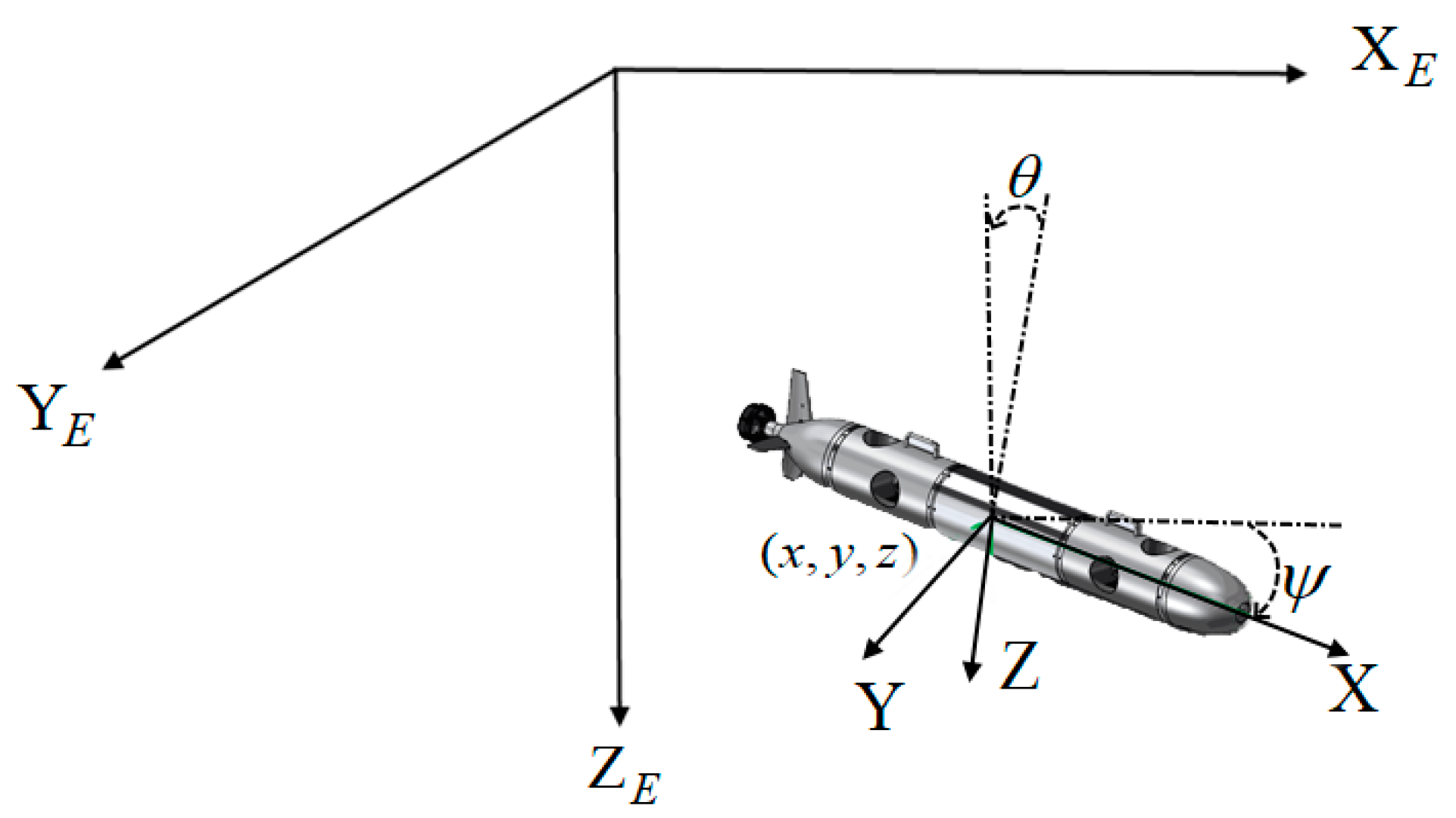
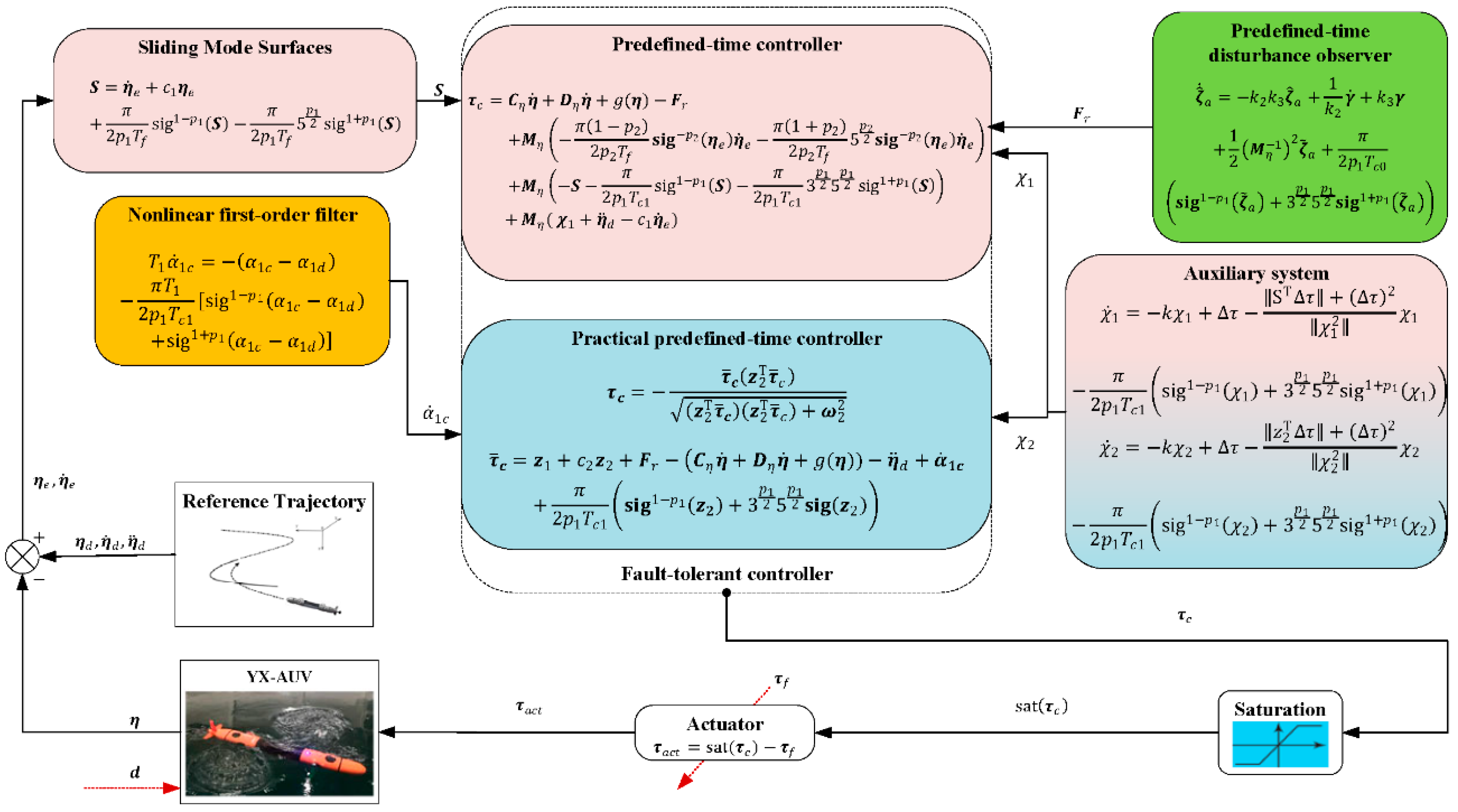

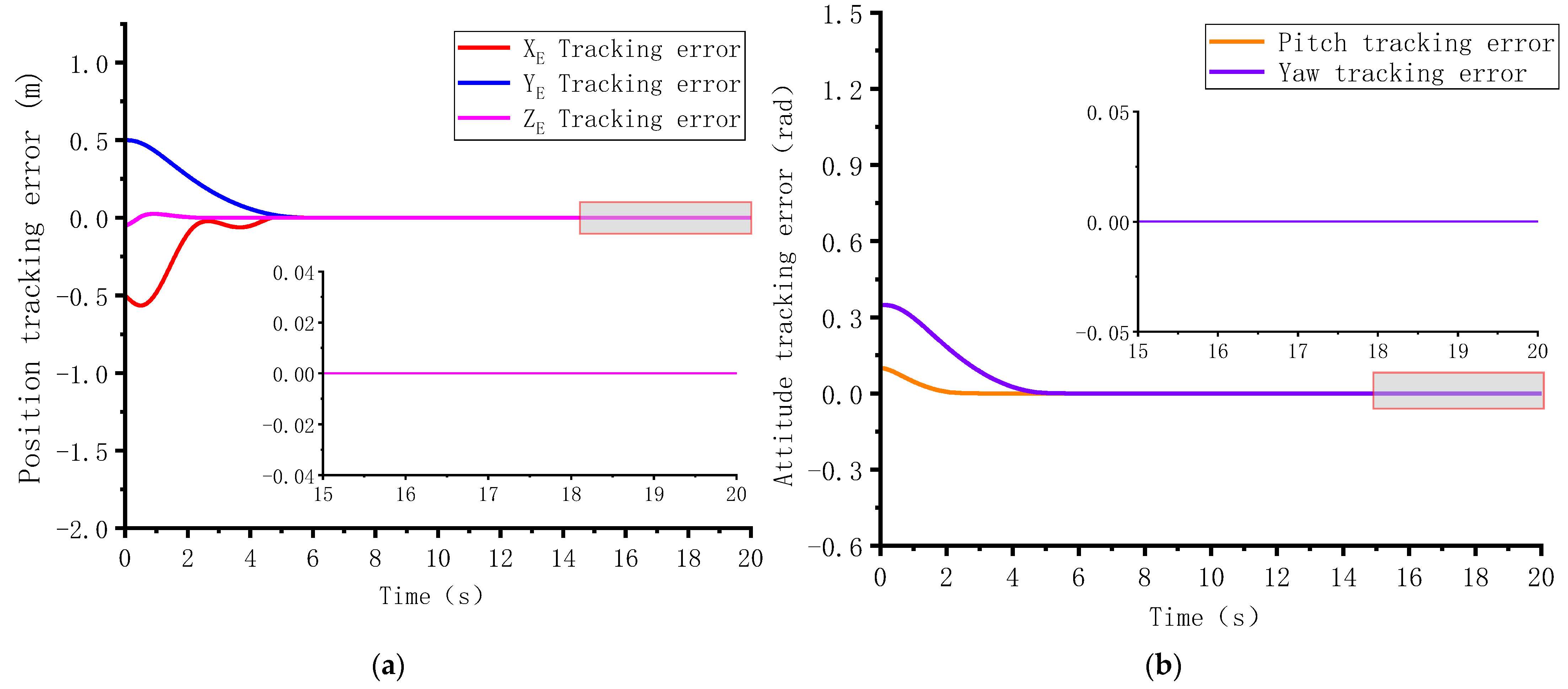
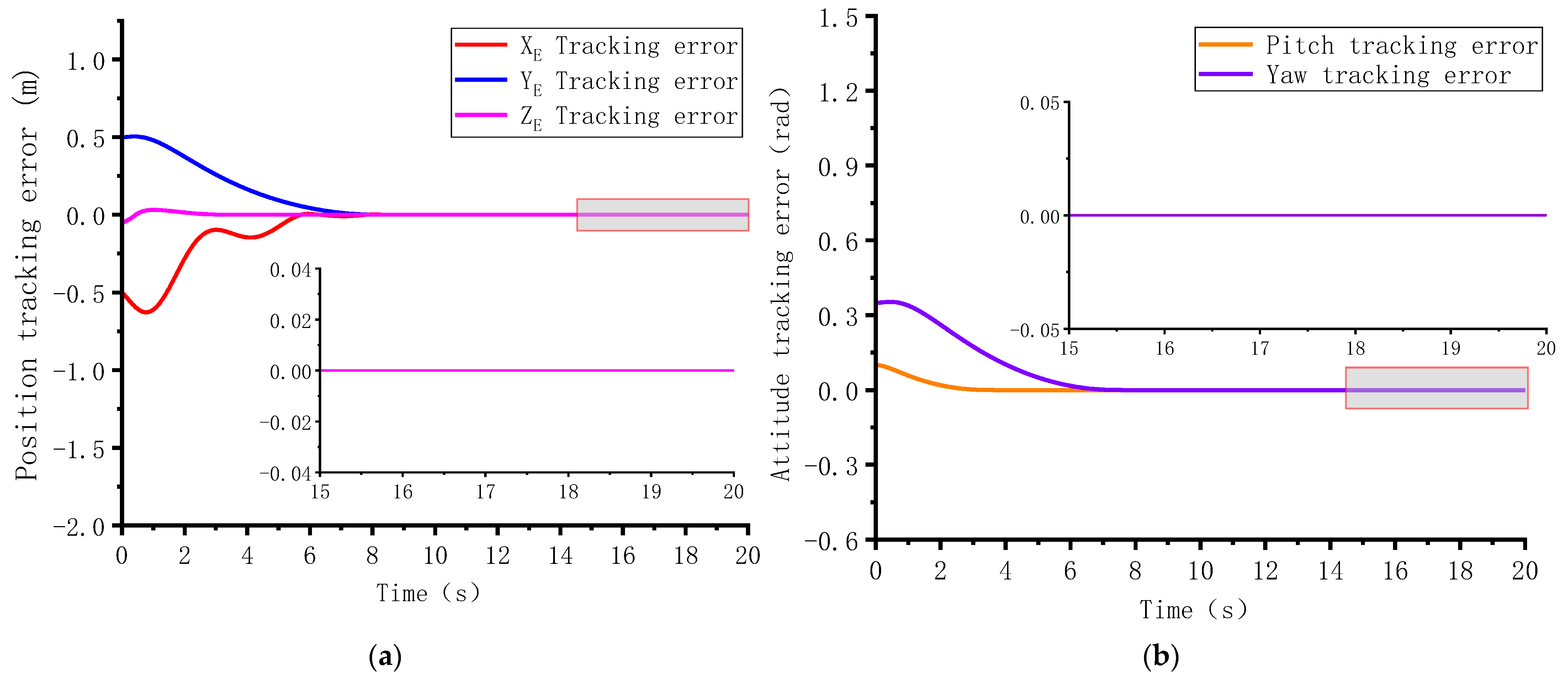
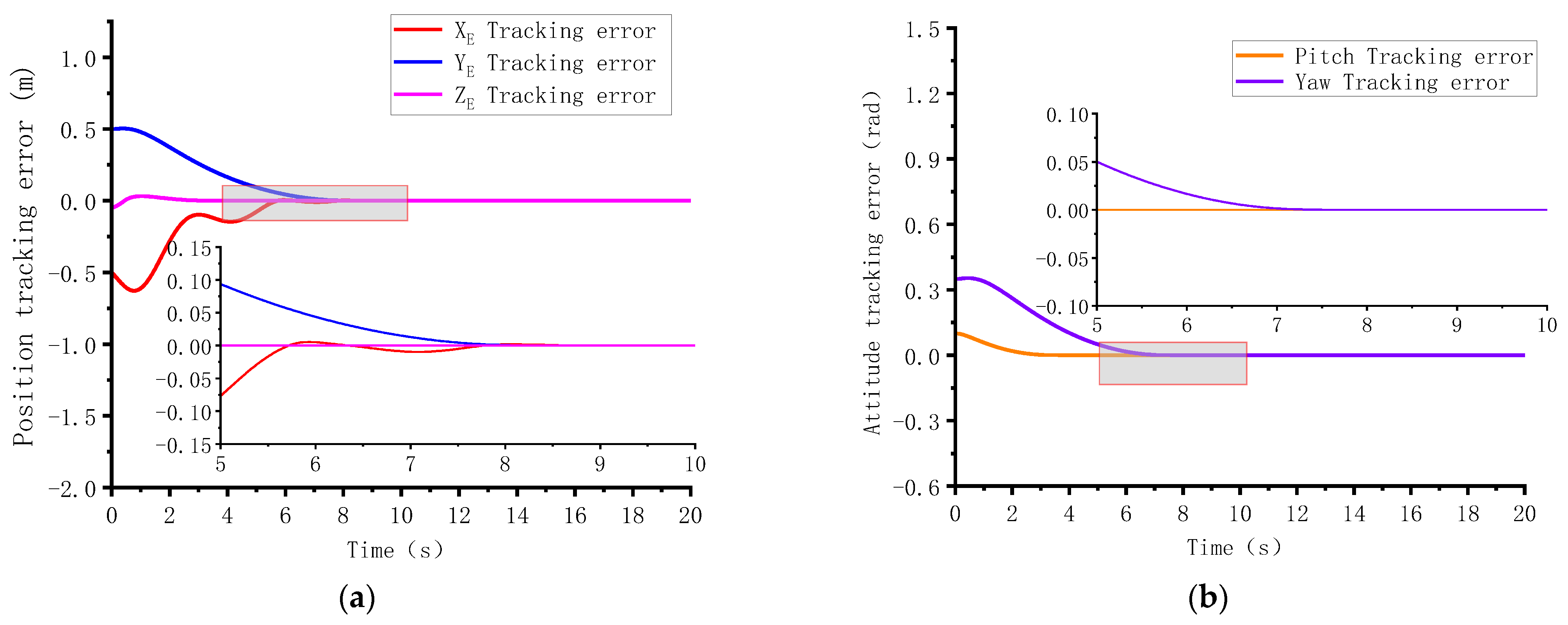
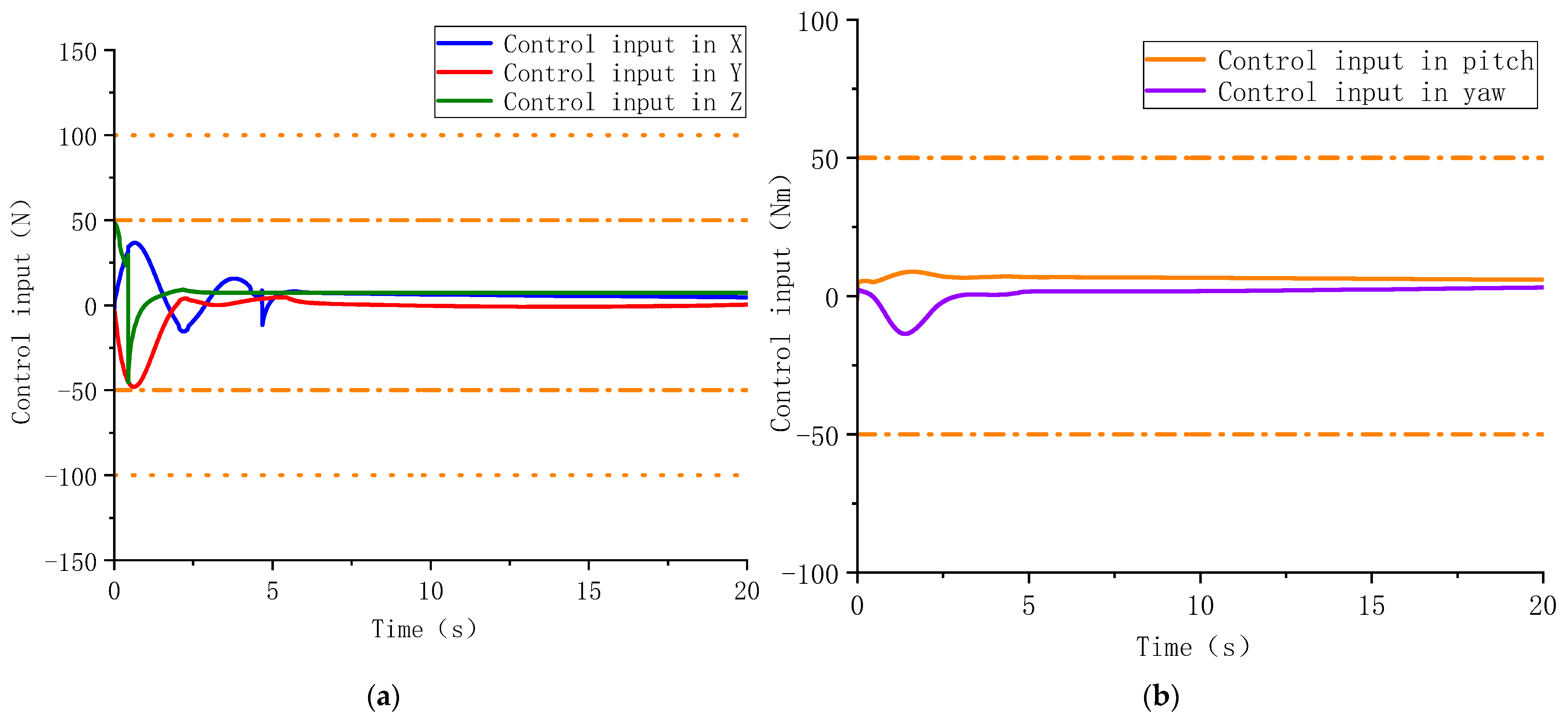
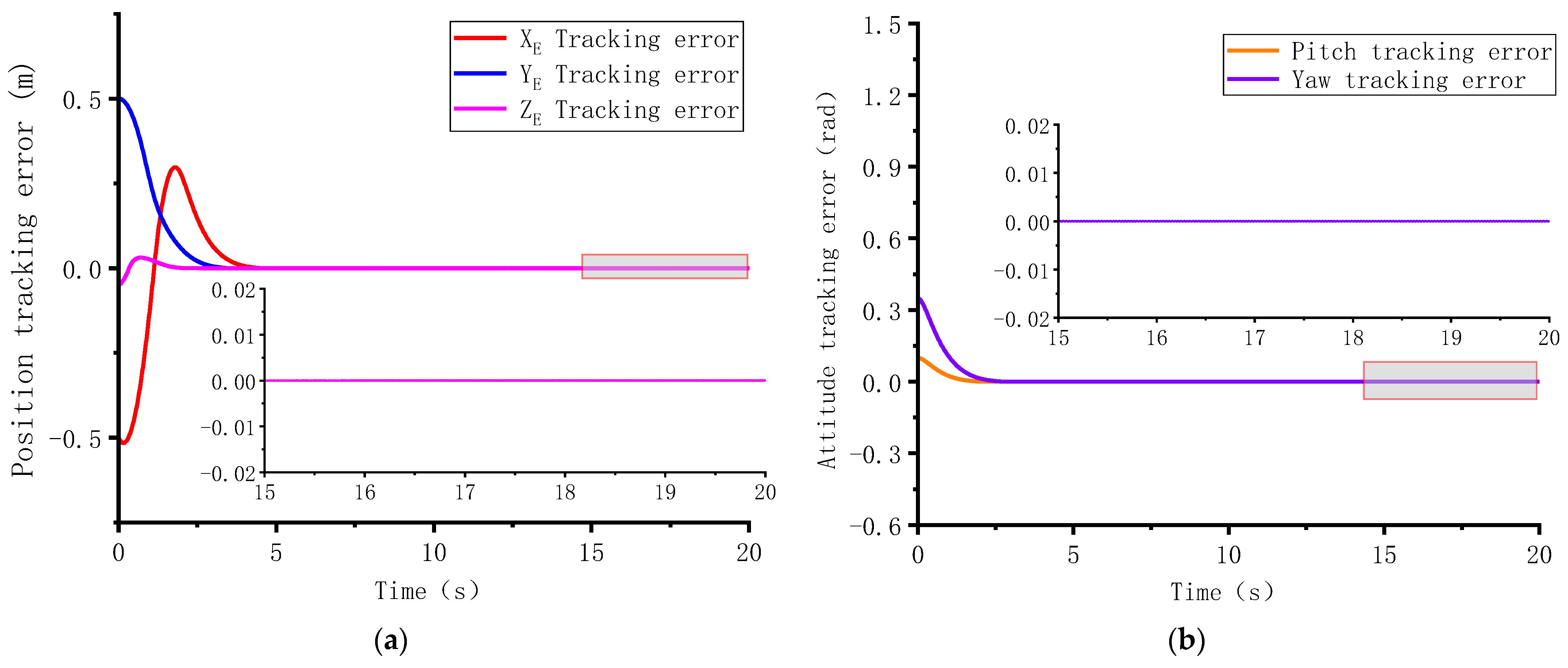

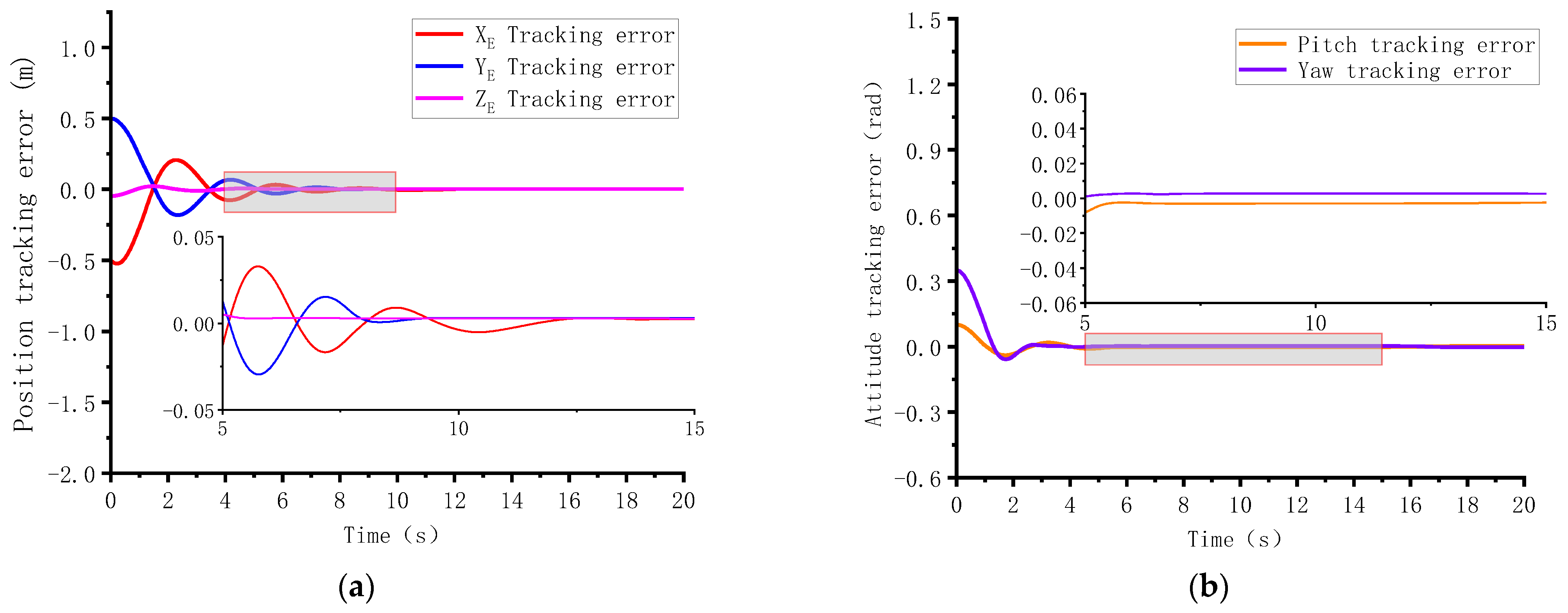
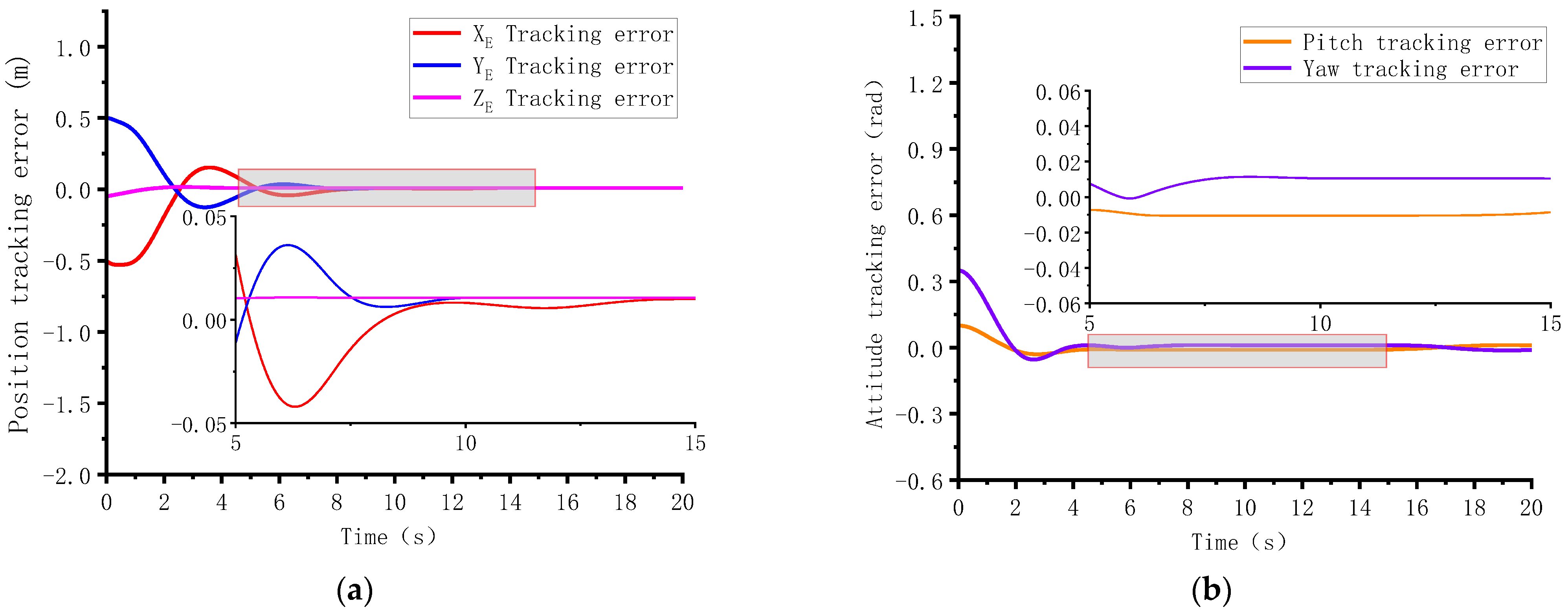
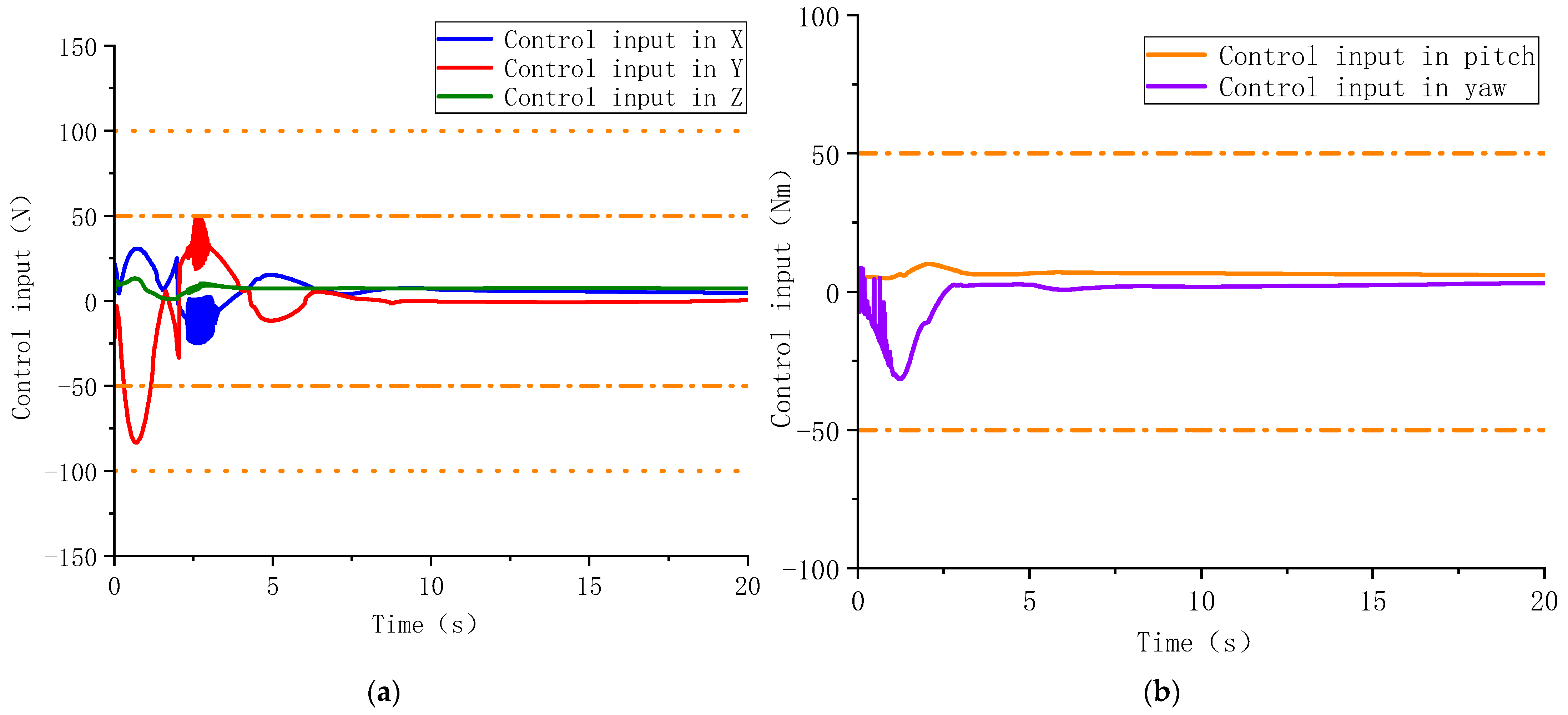
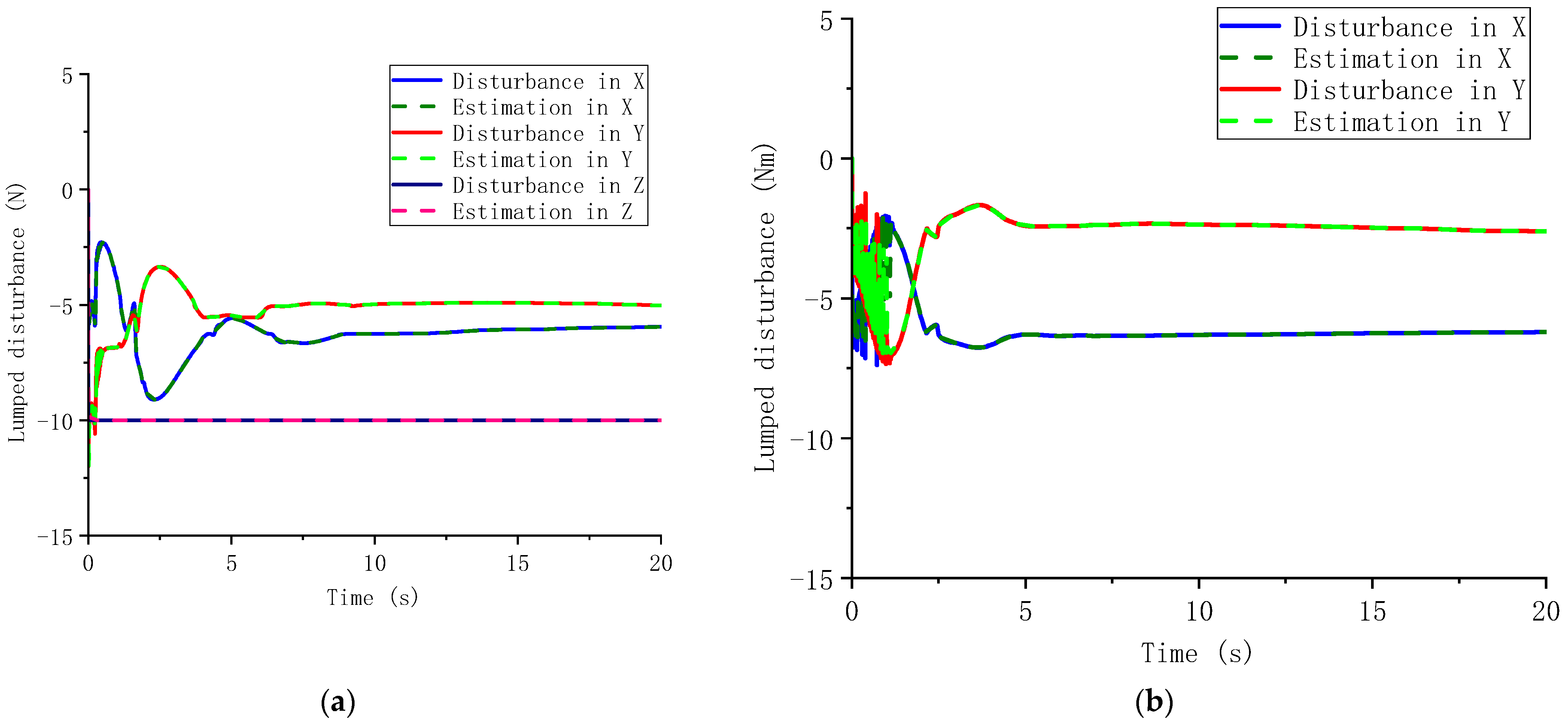
| Parameter | ||||
|---|---|---|---|---|
| Value | 30 kg | 0.1215 kgm2 | 5.468 kgm2 | 5.468 kgm2 |
| Parameters | Value | Parameters | Value |
|---|---|---|---|
| −7.14 kg | −67.7 kg | ||
| −5.8 kg/s | −49.15 kg/s | ||
| −9.29 kg/m | −79.71 kg/s | ||
| −60.63 kg | −0.48 kgm2 | ||
| −49.52 kg/s | −0.56 kgm2/s | ||
| −80.15 kg/m | −115.06 kgm2 |
Disclaimer/Publisher’s Note: The statements, opinions and data contained in all publications are solely those of the individual author(s) and contributor(s) and not of MDPI and/or the editor(s). MDPI and/or the editor(s) disclaim responsibility for any injury to people or property resulting from any ideas, methods, instructions or products referred to in the content. |
© 2023 by the authors. Licensee MDPI, Basel, Switzerland. This article is an open access article distributed under the terms and conditions of the Creative Commons Attribution (CC BY) license (https://creativecommons.org/licenses/by/4.0/).
Share and Cite
Li, Y.; He, J.; Zhang, Q.; Zhang, W.; Li, Y. Predefined-Time Fault-Tolerant Trajectory Tracking Control for Autonomous Underwater Vehicles Considering Actuator Saturation. Actuators 2023, 12, 171. https://doi.org/10.3390/act12040171
Li Y, He J, Zhang Q, Zhang W, Li Y. Predefined-Time Fault-Tolerant Trajectory Tracking Control for Autonomous Underwater Vehicles Considering Actuator Saturation. Actuators. 2023; 12(4):171. https://doi.org/10.3390/act12040171
Chicago/Turabian StyleLi, Ye, Jiayu He, Qiang Zhang, Wenjun Zhang, and Yanying Li. 2023. "Predefined-Time Fault-Tolerant Trajectory Tracking Control for Autonomous Underwater Vehicles Considering Actuator Saturation" Actuators 12, no. 4: 171. https://doi.org/10.3390/act12040171
APA StyleLi, Y., He, J., Zhang, Q., Zhang, W., & Li, Y. (2023). Predefined-Time Fault-Tolerant Trajectory Tracking Control for Autonomous Underwater Vehicles Considering Actuator Saturation. Actuators, 12(4), 171. https://doi.org/10.3390/act12040171






